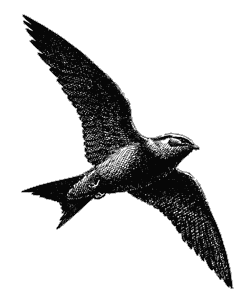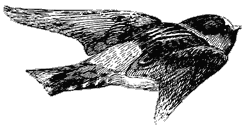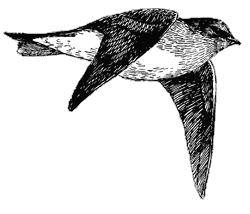Swallows
Swallows spend their days mostly in the air, often in flocks, plying the skies in search of the flying insects that make up the majority of their diet. With their graceful flight, musical voices, and sociable nature, these birds are popular with humans—and, it seems, the reverse is also true. Many kinds of swallows have prospered by learning to live alongside civilization.
 |
The biggest concentrations of swallows occur where there are swarms of flying insects, especially over water. Therefore, swallows are less numerous in the desert than in many other habitats. A few species are common here, however. Widespread but unobtrusive is the Northern Rough-winged Swallow, a brown bird that digs nesting tunnels in the vertical walls of dry arroyos and road cuts. Less sociable than most, it usually forages and nests in isolated pairs.
At one time, Cliff Swallows were quite localized in the Southwest. They required soft mud with which to build their gourd-shaped nests, and vertical or overhanging cliffs on which to place them. Modern civilization gave them an abundance of new sites: buildings close to watered lawns, and bridges over muddy creeks. Today Cliff Swallows are common in summer around many towns and roads in desert regions.
A true desert dweller is the local race of the Purple Martin, which nests in holes in saguaro cacti. Purple Martins in eastern North America today nest almost exclusively in multi-roomed birdhouses put up for them, but this habit has not yet caught on in the Southwest—our local martins are more independent of humans than are any other swallows here.
—Kenn KaufmanSwallows
Representative Sonoran Desert Species:
Purple Martin (Progne subis)
Northern Rough-winged Swallow (Stelgidopteryx serripennis)
Cliff Swallow (Hirundo pyrrhonota)
Order: Passeriformes
Family: Hirundinidae (Swallows)
Spanish names: golondrina (swallow)
Distinguishing features
Purple Martin: Largest swallow in North America; tiny bill, forked tail. Adult male: black with some purple iridescence, deeply forked tail. Adult female: dark gray upperparts with some purple, whitish-gray underparts with some speckling. Northern Rough-winged Swallow: Light brown above and white underparts, small bill, forked tail, brownish throat and chest. Cliff Swallow: Blackish cap, light spot above tiny bill, buff- colored rump, squared-off tail, whitish belly and rust-colored throat and cheek.
Habitat
Purple Martins are found in semi-open country near water, saguaro forest, and woodlands. Northern Rough-winged Swallows live near water, including streams, lakes, and riverbanks; also found in desert washes. Cliff Swallows are found in a variety of open to semi-open areas, especially when these areas are near water.
Feeding
• Diet: All 3 species feed on a wide variety of insects; spiders and other arthropods are also taken.
 |
• Behavior: These birds do nearly all of their foraging in the air. Their short, wide bills are ideally suited for snatching insects out of the air. They are often seen flying over water because of the abundance of insects. During bad weather these birds may resort to foraging on the ground.
Life History
Purple Martin: It uses naturally occurring sites, such as woodpecker holes in trees or saguaros. In eastern North America, most Purple Martins today nest in multi-roomed birdhouses put up to attact them.The cup-shaped nest, which is made by both sexes, consists of grass, twigs, leaves, feathers, and often mud. Whitish eggs (3 to 8) are incubated by the female and hatch in 15 to 18 days. The young leave the nest 26 to 31 days after hatching. Purple Martin numbers have been declining; the reasons are not well understood but may be due to competition with starlings.
 |
Northern Rough-winged Swallow: Unlike many species of swallows, this bird tends to nest singly. For nesting, the Rough-wings dig horizontal burrows in dirt stream banks, arroyo walls, or road cuts. They will also sometimes use holes in man-made structures. The bulky nest is made of weeds, twigs, and other vegetable matter. Four to 8 white eggs hatch in 12 to 16 days. Both parents feed the nestlings; young leave the nest 19 to 21 days after hatching. Because Rough-winged Swallows take advantage of man-made structures and areas of ground disturbance for nesting sites, they have actually benefited from the advance of civilization.
Cliff Swallow: This species most often uses elevated vertical surfaces with a protective overhang for nesting sites. Typical sites include cliff faces, buildings, and bridges. The gourd-shaped nest is made of mud and may be lined with feathers and possibly vegetable matter. Old nests are sometimes reused. Three to 6 white to pale pink spotted eggs are incubated by both parents and hatch in 14 to 16 days. The young leave the nest 26 to 31 days after hatching. This species nests in colonies of up to several hundred individuals.
Eggs
The egg of a bird consists of several parts. The yolk is a single giant cell, the true egg or ovum, produced in the ovary of a bird. The yellow material is mostly food for the growing embryo once the egg is fertilized. The ovum is released from the ovary and picked up by the oviduct where it is fertilized by sperm from a recent mating. As the ovum travels down the oviduct, layers of material are added in an assembly line fashion. First several layers of albumen (egg “white”), then two egg membranes, then the shell, and finally coloring. Most birds will lay one egg per day until they have a complete set. This set of eggs is called a clutch.
The color of the egg is related to its need to be camouflaged. Cavity
nesters usually lay all white eggs since they are out of sight. Ground
nesters lay brown, gray, or olive colored eggs, the color of the surrounding
vegetation. Tree nesting birds will lay white or blue eggs, splotched
or speckled with brown, to help conceal them in dappled light.![]()